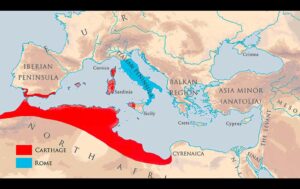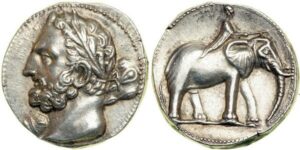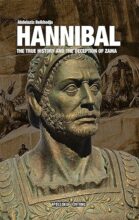All we know of Hannibal’s character is what his worst enemies deigned to divulge for posterity : a few rare tributes to his warrior qualities, drowned in a tide of calumny.
Hannibal emerged from the shadows during the Battle on the Tagus, in 220. To this day, nothing is known about his early childhood. Before Carthage was destroyed, Greek, Latin and Carthaginian biographies of Hannibal existed, perhaps even an autobiography, however none of these are extant. It appears as if the passage of time in no way mitigated the terror Hannibal inspired in Romans, which is possibly why not a single favorable testimonial of his achievements survives.
In 247-246, at the time of his birth, the eastern Mediterranean was undergoing evolution of great importance : Greek kingdoms were established from the remains of Alexander the Great’s conquests. Egypt, Syria and Asia Minor henceforth obeyed the orders of his generals’ successors and experienced an influx of Greek settlers. New monarchs promoted Greek culture, whilst safeguarding aspects from old civilizations encountered there. Faithful to Alexander’s spirit, they strove to create a kind of fusion among inhabitants, in which the Greek input would merely act as leaven. Thus, a new cultural model was established which gave birth to Greek inspired art, literature, style of life and political conceptions.
Remains found in Carthage by archaeologists provide us with a certainty : Greek was spoken and read in Hannibal’s birth town and all wares and goods from the Hellenistic civilization were used or emulated. Without ceasing to be Punic, the Carthage of that epoch was partially Hellenized.
During the same period, the First Punic War profoundly modified the balance of power in the western Mediterranean. At the beginning of the 3rd century BCE, Carthage occupied a dominant position in the area. Carthage’s trading posts in Sicily, Sardinia and Corsica and on the Spanish and North-African coasts, solidly bordered sea routes which beyond the Strait of Gibraltar, led directly either to the gold in the Gulf of Guinea, or to the pewter of the British coasts. This economic empire was fundamentally peaceful : Carthage didn’t enjoy warfare and aggressions from her enemies often caught her off-guard. The only form of military activity mastered by Carthage was naval combat, and her fleet boasted more than three hundred ships of exceptional maneuvering ability, which constantly roamed the western Mediterranean, to guarantee the safety of Carthage’s trading monopole.

However, Rome who had conquered the greater part of the Italic peninsula since the capture of Tarentum in 272, started to covet Sicily. At the beginning of 264, Roman armies advanced upon the city threatening Carthaginian possessions. Faced with a never-ending conflict, Rome realized that the only way of beating her enemy, was to equip herself with a powerful fleet.
The war effort was not supported by Carthaginian senators. Nonetheless, in the 17th year of the war, they grudgingly decided to send a new commander-in-chief to Sicily. In spite of the inadequacy of the means supplied, but thanks to his military genius, he would reclaim the initiative in the conflict.
Hamilcar Barca

Hamilcar Barca newly appointed at the head of Carthaginian forces in Sicily, would play a decisive role in skillfully steering Carthage in the choices she was confronted to. Hamilcar belonged to one of the great families of Punic aristocracy, that struggled against each other to dominate politics. He was well versed in the lessons of the Hellenistic world, he had chosen Greek tutors for his sons, while openly manifesting his attachment to the most traditional Carthaginian cults. Besides, he would reveal himself as a man of action of the first order.
The year in which Hannibal was born, Hamilcar, an influent member of the Reformers’ Party, was entrusted with the military command of Carthaginian forces in Sicily. The task was difficult as the military situation was desperate : the Carthaginian army was cornered in the western point of the island, and could no longer manage to stem Roman progression. Nonetheless, Hamilcar resumed control of the army, teaching it new combat techniques and restoring its courage.
In spite of limited means, he set up his principal camps in one of the most strategic locations in Sicily, from which he charted on-land commando operations, and sea raids against the Italian coastline. Gradually, he regained control over the entire western part of the island.
In order to defend herself and to recover the lead, Rome imposed a coercive war loan, thanks to which she was able to arm 200 quinqueremes and send them to the Sicilian coasts, under the command of Consul Lutatius Catulus. After an initial setback in 242, Catulus attacked a Carthaginian fleet transporting reinforcements and supplies on March 10th, 241. Massed and weightened by their cargoes, the Carthaginian ships stumbled into Catulus’ single-line, lightened vessels’ trap. Carthage lost 50 ships, 70 others were captured and 10,000 sailors were made prisoners.
Though critical, this setback wasn’t catastrophic as Carthage had risen up from far more momentous defeats. Nevertheless, the Conservative Party in power wanted peace. Hamilcar’s military feats which had filled Carthaginians with enthusiasm, (leading to their unconditional support for him) may have influenced the Elders into agreeing to a peace. In any case, they maintained that the coffers were empty, the economy in ruins and that Carthage could no longer afford to pursue the conflict. They didn’t consider Sicily as a crucial stake in Carthage’s future any more, as opposed to the Reformers, who under Hamilcar and his partisans’ impetus wanted to hold on to the island, convinced that Carthage’s prospective relations with Rome were at play there. The peace advocates won and Hamilcar received the order to engage in peace talks with Catulus. He acquitted himself of this duty, then resigned to mark his refusal of Carthage’s defeatist politics.
With the treaty of 241 Carthage lost Sicily and its surrounding islands. Carthage’s entire trade policy was destroyed, and the «Carthaginian Sea» became a sea open to all nations, principally to the winner.
For Carthage, this was merely an additional trial as she had already endured the Massiliots, the Etruscans and the Greeks of Sicily. The empire that was left – Africa, the south of Spain, the gateway to the Atlantic Ocean – was rich enough to ensure her lasting power, but Carthage would now have to come to grips with Roman imperialism.
Rome ratified the peace treaty. Aware that Hamilcar had safeguarded an intact army and that the conquest of Africa was not possible yet, Rome was nonetheless contemplating it and Carthage knew this. In point of fact, the peace of 241 was merely a truce. Carthage had to get ready for the inevitable resumption of hostilities.

Hannibal: The True History and the Deception of Zama (English Edition)

